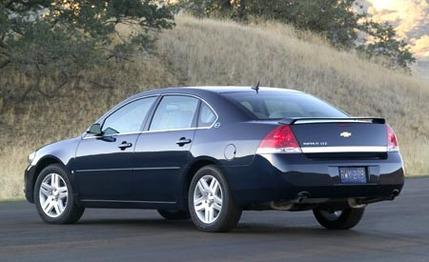 Short Take Road Test
Short Take Road Test
It's a good thing cars with animal names don't fully embody the character of their namesakes. A Dodge Viper, then, would not only be capable of killing an inexperienced driver but would be actively trying to do so with a series of sudden, unpredictable strikes. It would likely succeed. Ford Mustangs would stampede about in huge herds that would run other vehicles off the road. And Volkswagen's upcoming Tiguan crossover—the name is a combination of the German words for tiger and iguana—would be the sort of terrifying monster that would give children nightmares.
What of Chevrolet's Impala? It would be a timid, graceful car, quiet and fast. The Impala SS does the fast part of that formula well, but a sort of traction-control-induced torque steer means it isn't so timid or graceful. In search of a more docile Impala, we tried one with the 3.9-liter V-6 instead of the snort-and-pound-your-hooves 303-hp V-8 in the SS.
Although the idea of the base 211-hp, 3.5-liter V-6 would drop our eyelids, the 3.9-liter V-6 is not a bad choice in this car. It feels strong, even at higher rpm and speed, and never sounds labored. Its 233 horsepower is enough to giddyap to 60 mph in 7.4 seconds, and the 15.6-second quarter-mile pass at 91 mph is respectable for what this car is. With more than just four gears in the automatic transmission, these figures should be a little better. That six-speed from the Lambda-platform SUVs (the Buick Enclave, the GMC Acadia, and the Saturn Outlook) needs to be adapted pronto to the rest of GM's lineup.
A Suspension Tuned for Highway Monotony
To reduce consumption on those long highway slogs this car does best, the 3.9 gets outfitted with cylinder deactivation, which allows the V-6 to run on just three cylinders in low-load situations. Even so, we recorded only 18 mpg over roughly 300 miles of driving, and the dashboard indicator showed the engine running on all six cylinders most of the time.
The Impala's suspension is also set up more for long, straight roads than for those that compel a driver to test the margin by which he can exceed the recommended speed on a given corner. In a straight line, the Impala soaks up bumps well—occupants hear more of a crash than the slight jiggle they feel—but once the road starts to wind, the Impala dips, leans, and squats as though the road were one big yoga mat. Steering inputs are likewise imprecise, needing about 15 degrees of input before the car starts to react.
This works in concert with the Impala's softly padded seats. Sitting still or cruising in a straight line, we find the buckets to be as comfortable as our favorite recliner. Unfortunately, the seats offer lateral support in correlation to body weight—the deeper you sink into the seat, the more lateral support you've created for yourself. The slightest hint of aggression will rock you out of your comfort zone and test your lat muscles. Those in the back seat will find a comfortable space that starts to feel small during interstate travel. But with 19 cubic feet of trunk space, more than in a BMW 7-series and just one cube shy of a Mercedes-Benz S-class's, passengers can bring along enough stuff to feel crowded everywhere they go.
The Impala also caters to long-haul travelers by having three power points. Two are tucked out of sight at the base of the center stack in the bottom of a deep storage tray, and a third is in the center console, so you can power the cell-phone charger, the radar detector, and the iPod. Cue the Lee Greenwood; power for all our stuff is what America is all about.